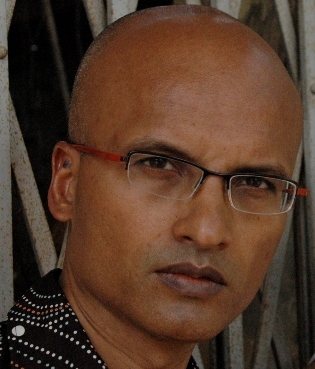The star
of Narcopolis, Jeet Thayil's debut
novel about Bombay, is Dimple, a transsexual burkha-wearing sex worker
searching for beauty and transcendence while managing her addiction to opium.
If that’s not enough “Other” to get your attention, you
should know that Thayil navigates the complex terrains of religion, sexuality
and addiction with a startling tenderness. “Woman
and man are words other people use, not me,” Dimple
says to the narrator. “I’m not sure what I am.” Later, when the narrator
reads to the mostly illiterate Dimple a review of the work of Newton Xavier, an
aging “postmodern subversive” artist, Dimple looks at the pictures of his paintings and
proclaims “he wants to make everything
ugly. He wants to kill the world. She said, how you can you trust a man like
that?”
Most of
the book centers on Dimple’s relationship with Mr. Lee, a
self-exiled Chinese national who keeps the best opium pipes in the city and
dreams of the day when his ashes can return home. The two forge an unlikely
alliance: Mr. Lee takes Dimple in and provides her with safety, comfort and a
profession, and Dimple serves as his caretaker, companion and apprentice. There’s an idyllic quality to these chapters and the reader gets
the sense that these were the happy times in Dimple’s life. It is with Mr. Lee that she starts to reflect on
what it is she really values and it is here that we get a glimmer of what
Dimple is searching for:
Her favorite book was a slim collection of prophecies by a
nun who wrote in Konkani ... The book was terrifying, not
because it contained endless description of civil butchery and mass suicide,
but because of the serene accompanying sketches of trees, streams, and sunbirds … And though she knew she was dreaming, that Sister Remedios’s book was her own invention and the world was as intact as
it had ever been, she whimpered in her sleep at the ferocity of her dreams.
Beauty
and identity. Trust and betrayal. Sainthood and destruction. These are the issues
that concern Dimple as she descends further and further into the seedy
underbelly of Bombay’s opium dens. Dimple’s dreams captivate her even as they terrify her. They have
the trappings of religious ecstasy and the wondrous, horrifying visions she
sees.

Photo of the author by Suguna Sridhar
The
demise of Mr. Lee combined with the arrival of cheap, dangerous heroin into the
city drives Dimple out of her home and propels her into a darker, less
forgiving world. The drugs are harder, the people are more violent. She meets
Rashid, a devout Muslim, opium den owner, and pimp who protects her but also
traps her in the world by taking advantage of her sexually and enabling her
addiction. Rashid demands that Dimple wear a burkha to entice the primarily
Muslim clientele. “To want a woman to wear this
thing,” she thinks, “you had to know the danger that lay in looking.” Beatings become commonplace. Prostitution becomes more and
more hazardous. Men murder each other in the street with hammers and heroin
becomes the poisoned lifeblood of the city. Even so, she continues her search
for beauty. She explores works of art, she picks up books on reincarnation, she
interrogates poets -- all in the quest to
understand herself and her visions.
As the
city becomes consumed by destruction and drug abuse, she is haunted both
literally and figuratively by Mr. Lee and the promise to him that she is unable
to keep. As the city destroys itself around her and she succumbs to her
addiction, Dimple makes one last effort to save herself, fleeing to the Safer
rehab clinic.
Yet
through it all, Dimple retains her dignity and grace even in her most desolate
moments. When asked why she does drugs, a dying Dimple replies "it isn't
the heroin that we're addicted to, it's the drama of the life, the chaos of it,
that's the real addiction and we never get over it; and because when you come
down to it, the high life, that is, the intoxicated life, is the best of the
limited options we are offered -- why would we choose anything
else?" Even in this moment, Dimple focuses on the best that life can give
her and it is here, alone and dying in the clinic, dreaming her crazed,
prophetic dreams, that we realize that the beauty that Dimple has been
searching for all along is in herself. Through Dimple, Thayil gives his readers
a startling and unconventional portrait of a saint.
Thayil is
a gifted storyteller and the issues he chooses to explore in the book as well
as his careful attention to character make Narcopolis a
gripping read. Dimple’s unrelenting search for
beauty and unwavering commitment to goodness makes what could be a difficult
story engaging and entertaining. His attention to the
lives of characters at the margins both presents us with a human picture of the
opium trade as well as a rich portrait of India’s
diversity. That’s not to say that Narcopolis does not have its flaws. The disappearance of the frame
narrator for most of the book and his abrupt reappearance to bring Dimple to the
rehab clinic reads more like a convenient plot device than substantive
character development. Other secondary characters also drop in and out of the
novel with the same abruptness. But on the whole, Thayil manages to paint a
compelling picture of Bombay just as everything begins to fall apart. The moments
of beauty that permeate the work make the brutality of the world he’s created not only bearable but compelling. It’s a stunning accomplishment and a monumental first novel.
G. Justin Hulog writes stories about ruined gods, forgotten spaces and
new worlds. Born in Baguio City, he grew up in California before
leaving home to study Comparative Literature at Columbia University.






Comments